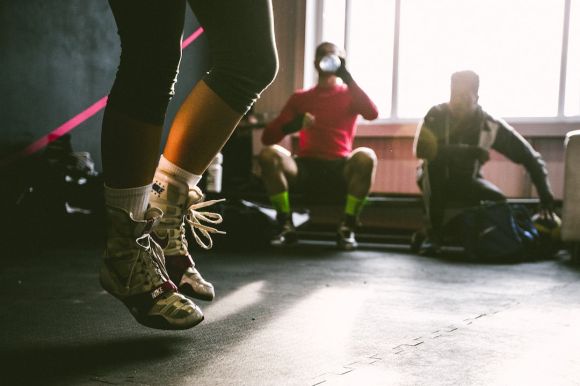Every athlete knows that to excel in their chosen sport, they need to build both endurance and strength. While general workouts can be beneficial, incorporating sports-specific exercises into your training routine can take your performance to the next level. These workouts focus on the specific movements and skills required in your sport, helping you build the necessary strength and endurance to dominate on the field, court, or track.
Blog Posts
Maintaining a healthy cardiovascular system is essential for overall well-being. Exercise is a powerful tool that can help improve cardiovascular health and reduce the risk of heart disease. By incorporating regular physical activity into your routine, you can strengthen your heart, improve blood circulation, and lower your blood pressure. In this article, we will explore various exercises that are beneficial for your cardiovascular health and provide tips on how to incorporate them into your daily life.
Aerobic Exercises: The Key to a Healthy Heart
Aerobic exercises, also known as cardiovascular exercises, are particularly effective in improving cardiovascular health. These exercises increase your heart rate and make your heart stronger. Some examples of aerobic exercises include walking, jogging, cycling, swimming, and dancing. These activities engage large muscle groups and require continuous movement, making them ideal for improving cardiovascular fitness.The Importance of Moderate Intensity
When engaging in aerobic exercises, it is important to aim for moderate intensity. This means that you should be working hard enough to raise your heart rate and break a sweat, but still be able to carry on a conversation. Moderate-intensity exercises provide a challenging workout for your heart without putting excessive stress on it. By gradually increasing the intensity of your workouts over time, you can continually challenge your cardiovascular system and reap the benefits.Interval Training: A Time-Efficient Option
Interval training is an excellent way to boost cardiovascular fitness in a shorter amount of time. This type of training involves alternating between high-intensity bursts of exercise and periods of rest or low-intensity exercise. For example, you can alternate between sprinting and walking, or cycling at a high intensity for a short period followed by a slower pace. Interval training not only improves cardiovascular health but also helps burn calories and increase endurance.Strength Training: Supporting Cardiovascular Health
While aerobic exercises are essential for cardiovascular health, strength training should not be overlooked. Building muscle strength is important for overall fitness and can indirectly support cardiovascular health. Strength training exercises, such as weightlifting or bodyweight exercises, help increase muscle mass, which in turn increases your metabolism. A higher metabolism helps your body burn more calories, maintain a healthy weight, and reduces the risk of developing heart disease.Incorporating Exercise into Your Daily Life
To improve cardiovascular health, it is important to make exercise a regular part of your daily life. Here are some tips to help you incorporate exercise into your routine: 1. Start with small steps: Begin by incorporating short bouts of physical activity into your day, such as taking the stairs instead of the elevator or going for a short walk during your lunch break. 2. Set achievable goals: Gradually increase the duration and intensity of your workouts. Set realistic goals that you can work towards, such as aiming to exercise for 30 minutes a day, five days a week. 3. Find activities you enjoy: Choose exercises that you enjoy doing to make it easier to stick to your routine. Whether it's dancing, swimming, or playing a sport, finding activities that you find enjoyable will make exercise feel less like a chore. 4. Make it a social activity: Exercise with a friend or join a group fitness class. Having a workout buddy or being part of a community can provide motivation and make exercising more enjoyable. 5. Be consistent: Consistency is key when it comes to improving cardiovascular health. Aim to exercise regularly, even if it's just for a few minutes each day. Consistency will yield long-term benefits for your heart health. In conclusion, exercise plays a crucial role in improving cardiovascular health. By incorporating aerobic exercises, interval training, and strength training into your routine, you can strengthen your heart, improve blood circulation, and lower your blood pressure. Remember to start small, set achievable goals, and make exercise a regular part of your daily life. With consistency and dedication, you can improve your cardiovascular health and enjoy the benefits of a stronger heart.
Staying properly hydrated is crucial for maintaining overall health and well-being, but it becomes even more important when it comes to fitness. Whether you're an avid athlete or just starting out on your fitness journey, ensuring that you are adequately hydrated can greatly impact your performance and recovery. In this article, we will explore the significance of hydration for fitness and provide some tips on how to stay properly hydrated.
Optimal Performance
One of the key benefits of staying hydrated during exercise is the improvement in performance. Dehydration can have a negative impact on various aspects of physical performance, including strength, endurance, and speed. When you are dehydrated, your body's ability to transport oxygen and nutrients to the muscles is compromised, leading to muscle fatigue and decreased performance. Proper hydration allows your muscles to function optimally, enabling you to perform at your best. It helps maintain electrolyte balance, which is essential for muscle contractions and nerve function. By staying hydrated, you can enhance your stamina, power, and overall athletic performance.Prevention of Fatigue
Fatigue is a common issue that many individuals face during exercise. It can significantly hinder your ability to perform at your peak. One of the primary causes of fatigue is dehydration. When you are dehydrated, your blood volume decreases, making your heart work harder to circulate oxygen and nutrients throughout your body. This increased strain on your cardiovascular system can lead to feelings of exhaustion and fatigue. By staying properly hydrated, you can prevent dehydration-related fatigue and maintain your energy levels throughout your workout. This will allow you to push harder, train longer, and achieve better results.Improved Recovery
Proper hydration is not only essential during exercise but also plays a vital role in post-workout recovery. When you engage in physical activity, your body loses fluids through sweat. Replenishing these lost fluids is crucial for the recovery process. Hydration aids in the removal of waste products from your muscles and helps with the delivery of nutrients to promote muscle repair and growth. It also helps regulate your body temperature, which can be elevated during intense workouts. By drinking enough water, you can reduce muscle soreness, promote faster recovery, and minimize the risk of injury.Tips for Staying Hydrated
Now that we understand the importance of hydration for fitness, let's explore some practical tips to stay properly hydrated: 1. Drink water before, during, and after your workouts. Aim to consume at least 8 ounces of water before exercising and continue to hydrate throughout your session. 2. Monitor your urine color. Pale yellow urine indicates good hydration, while dark-colored urine suggests dehydration. 3. Consider incorporating sports drinks or electrolyte-replenishing beverages into your routine for more intense workouts lasting longer than an hour. 4. Eat water-rich foods such as fruits and vegetables to supplement your fluid intake. 5. Carry a water bottle with you throughout the day as a reminder to drink regularly.Conclusion
Staying properly hydrated is essential for maximizing your fitness potential. It improves performance, prevents fatigue, and aids in post-workout recovery. By following simple tips like drinking water before, during, and after exercise, monitoring urine color, and incorporating water-rich foods, you can ensure that you stay adequately hydrated. Remember, proper hydration is not just a matter of preference, but a necessity for achieving your fitness goals.
In today's busy world, finding time to go to the gym can be a challenge. However, that doesn't mean you can't get in a good workout right at home. High intensity home workouts are a great way to burn calories and get fit without needing expensive equipment or a large time commitment. In this article, we will explore the benefits of high intensity workouts and provide you with some effective exercises to try at home.
Benefits of High Intensity Workouts
High intensity workouts, also known as HIIT (High Intensity Interval Training), have gained popularity in recent years due to their ability to burn a significant amount of calories in a short period of time. Unlike traditional workouts that focus on steady-state cardio, HIIT workouts involve short bursts of intense exercise followed by brief periods of rest or active recovery. This type of training not only helps burn calories during the workout but also increases your metabolism, allowing you to continue burning calories even after you've finished exercising.Effective High Intensity Exercises for Home Workouts
1. Jumping Jacks: Start with your feet together and arms by your sides. Jump up, spreading your legs wide and raising your arms above your head. Land softly and return to the starting position. Repeat for 30 seconds. 2. Squat Jumps: Stand with your feet shoulder-width apart. Lower into a squat position, keeping your knees behind your toes. Explosively jump up, extending your arms overhead. Land softly and immediately lower back into a squat. Repeat for 30 seconds. 3. Mountain Climbers: Begin in a high plank position with your hands directly under your shoulders. Bring one knee towards your chest and then quickly switch legs, mimicking a running motion. Continue alternating legs for 30 seconds. 4. Burpees: Start in a standing position. Lower into a squat and place your hands on the floor in front of you. Jump your feet back into a plank position, perform a push-up, and then jump your feet back towards your hands. Explosively jump up, reaching your arms overhead. Repeat for 30 seconds. 5. High Knees: Stand with your feet hip-width apart. Drive one knee up towards your chest while quickly switching to bring the opposite knee up. Continue alternating legs as quickly as possible for 30 seconds. 6. Plank Jacks: Begin in a high plank position. Jump your feet wide apart and then quickly jump them back together, mimicking a jumping jack motion. Continue for 30 seconds. 7. Bicycle Crunches: Lie on your back with your knees bent and hands behind your head. Lift your shoulder blades off the floor and bring one elbow towards the opposite knee while extending the other leg out straight. Switch sides, bringing the opposite elbow towards the opposite knee. Continue alternating sides for 30 seconds.Conclusion
High intensity home workouts are a convenient and effective way to burn calories and get fit. By incorporating exercises such as jumping jacks, squat jumps, mountain climbers, burpees, high knees, plank jacks, and bicycle crunches, you can challenge your body and achieve great results in a short amount of time. Remember to warm up before starting your workout and cool down afterwards to prevent injury. So, why wait? Start incorporating high intensity home workouts into your fitness routine today and watch the calories burn away!
Are you looking for a new and exciting way to challenge yourself physically and mentally? Look no further than the Fit on Agility Training Competition! This thrilling event is designed to test your agility and push your limits in a fun and competitive environment. Whether you are a seasoned athlete or just starting your fitness journey, this competition is the perfect opportunity to showcase your skills and see how you measure up against others.
What is Agility Training?
Agility training is a form of exercise that focuses on improving coordination, speed, and reaction time. It involves a variety of movements such as jumping, running, and changing direction quickly. By incorporating these movements into your training routine, you can enhance your overall agility and physical performance.The Benefits of Agility Training
Agility training offers numerous benefits for individuals of all fitness levels. Not only does it improve physical abilities, but it also enhances cognitive function. The quick decision-making required during agility training exercises helps sharpen your mental acuity and improves your ability to react to changing situations. Additionally, agility training can help reduce the risk of injury by improving your balance and flexibility. It also enhances your athletic performance in sports that require quick movements and rapid changes in direction, such as basketball, soccer, and tennis.What to Expect at the Fit on Agility Training Competition
The Fit on Agility Training Competition is a one-of-a-kind event that will put your agility skills to the test. Participants will compete in a series of challenges that will challenge their speed, coordination, and quick thinking. From obstacle courses to agility ladder drills, each challenge is designed to push participants to their limits and provide an exhilarating experience. Participants will be divided into different categories based on their age and fitness level to ensure fair competition. This means that whether you are a beginner or an advanced athlete, there is a category for you to compete in. Each category will have its own set of challenges, allowing participants to compete against others of similar abilities.How to Prepare for the Competition
To give yourself the best chance of success at the Fit on Agility Training Competition, it is important to prepare adequately. Incorporate agility training exercises into your regular workout routine to improve your speed, coordination, and reaction time. Focus on exercises that target the muscles used in agility movements, such as plyometrics, ladder drills, and cone drills. In addition to physical preparation, it is essential to fuel your body with a balanced diet and adequate hydration. Proper nutrition will provide you with the energy and nutrients needed to perform at your best during the competition.Conclusion: Take the Leap and Test Your Agility
If you are looking to challenge yourself and take your fitness to the next level, the Fit on Agility Training Competition is the perfect opportunity. This exciting event will test your agility skills and push you to new limits. With a variety of challenges and categories for all fitness levels, there is something for everyone to enjoy. So, gather your friends, lace up your sneakers, and get ready to show off your agility skills at the Fit on Agility Training Competition!
Are you looking to take your fitness to the next level? Do you want to increase your explosive power and agility? Look no further than the Fit on Plyometric Challenge! This intense training program is designed to push your limits and help you achieve peak performance. In this article, we will explore the benefits of plyometric training and how you can join the challenge to improve your athletic abilities.
What is Plyometric Training?
Plyometric training, also known as jump training, is a form of exercise that focuses on explosive movements. It involves rapid contractions of the muscles, followed by quick stretching and eccentric contractions. This type of training targets the fast-twitch muscle fibers, which are responsible for generating power and speed.Benefits of Plyometric Training
1. Increased Power: Plyometric exercises require a high level of force production in a short amount of time. By regularly incorporating these exercises into your routine, you can increase your power output, allowing you to jump higher and run faster. 2. Improved Speed and Agility: Plyometric training enhances your agility and reaction time, making you more agile and quick on your feet. This is particularly beneficial for athletes participating in sports that require sudden bursts of speed and change of direction. 3. Enhanced Coordination: Plyometric exercises involve complex movements that require coordination between multiple muscle groups. By practicing these exercises, you can improve your overall coordination and body control. 4. Stronger Bones and Joints: Plyometric training is a weight-bearing exercise that helps strengthen your bones and joints. This can reduce the risk of injuries, such as fractures and sprains, especially in high-impact sports.Join the Fit on Plyometric Challenge
Now that you understand the benefits of plyometric training, it's time to join the Fit on Plyometric Challenge! This challenge is designed to push your limits and help you achieve your fitness goals. Here's how you can get started: 1. Set Your Goals: Before starting the challenge, it's important to set clear goals for yourself. Do you want to improve your vertical jump? Increase your sprint speed? Define what you want to achieve during the challenge, and use it as motivation throughout the program. 2. Consult a Professional: If you're new to plyometric training or have any underlying health conditions, it's always a good idea to consult with a fitness professional. They can assess your current fitness level and provide guidance on how to safely progress through the challenge. 3. Start Slowly: Plyometric exercises can be intense on your muscles and joints, so it's important to start slowly and gradually increase the intensity. Begin with basic exercises, such as squat jumps and box jumps, and gradually progress to more advanced movements. 4. Stay Consistent: Consistency is key when it comes to plyometric training. Aim to perform the exercises at least two to three times per week, and gradually increase the duration and intensity as you progress. Remember to listen to your body and take rest days when needed. 5. Track Your Progress: Keep a record of your workouts and track your progress throughout the challenge. This will help you stay motivated and see how far you've come. Celebrate your achievements along the way, no matter how small they may seem. By joining the Fit on Plyometric Challenge, you can take your fitness to new heights and unlock your explosive power. Remember to always prioritize safety and listen to your body. Get ready to jump, sprint, and unleash your full athletic potential!
Cardio workouts, also known as aerobic exercises, are a fantastic way to improve your overall fitness and burn calories. However, many people make common mistakes that can hinder their progress or even lead to injury. In this article, we will discuss some of these mistakes and provide helpful tips on how to avoid them.
Skipping the Warm-up
One of the biggest mistakes people make before starting a cardio workout is skipping the warm-up. A proper warm-up is essential to prepare your body for exercise and prevent injuries. It increases your heart rate gradually, warms up your muscles, and improves joint mobility. Spend at least 5-10 minutes doing light aerobic exercises, such as jogging in place or jumping jacks, before diving into your main workout.Neglecting Proper Form
Maintaining proper form during cardio exercises is crucial to prevent injuries and maximize the effectiveness of your workout. Many people make the mistake of sacrificing form for speed or intensity. For example, when running, avoid slouching or leaning forward, as this can strain your lower back. Instead, focus on keeping your back straight, shoulders relaxed, and arms at a 90-degree angle.Overtraining
While it's important to challenge yourself during cardio workouts, overtraining can do more harm than good. Pushing yourself too hard and too frequently can lead to fatigue, decreased performance, and even overuse injuries. It's crucial to listen to your body and give yourself enough time to recover between workouts. Aim for at least one or two rest days each week to allow your muscles to repair and rebuild.Not Mixing Up Your Routine
Doing the same cardio workout day in and day out can lead to a plateau in your progress and make your workouts feel monotonous. To avoid this, incorporate different types of cardio exercises into your routine. Try activities like swimming, cycling, dancing, or using the elliptical machine. Not only will this keep your workouts interesting, but it will also challenge your body in new ways and target different muscle groups.Ignoring Strength Training
While cardio workouts are excellent for improving cardiovascular health, they may not be enough to achieve your fitness goals. Neglecting strength training is a common mistake many people make. Incorporating strength exercises, such as weightlifting or bodyweight exercises, into your routine can help build lean muscle mass, increase metabolism, and improve overall strength. Aim for at least two days of strength training per week, alternating between upper and lower body exercises.Not Listening to Your Body
Perhaps the most crucial mistake to avoid during cardio workouts is not listening to your body. Pay attention to any pain, discomfort, or unusual sensations during your workout. Pushing through pain can lead to injuries, so it's important to take a break and seek medical attention if needed. Additionally, if you're feeling excessively fatigued or experiencing prolonged muscle soreness, it may be a sign that you need to adjust your workout intensity or take a rest day. In conclusion, cardio workouts are a fantastic way to improve fitness and burn calories. By avoiding common mistakes such as skipping the warm-up, neglecting proper form, overtraining, not mixing up your routine, ignoring strength training, and not listening to your body, you can ensure that your cardio workouts are both safe and effective. Remember to always prioritize your health and well-being when engaging in any form of exercise.
Running is a popular form of exercise that offers numerous health benefits, such as improved cardiovascular fitness, weight management, and stress reduction. However, poor running form can lead to injuries and hinder your progress. By focusing on your technique, you can improve your running form and reduce the risk of injuries. Here are some tips to help you get started:
1. Maintain Good Posture:
Proper posture is essential for efficient running and injury prevention. Keep your head up, eyes forward, and shoulders relaxed. Avoid slouching or leaning too far forward or backward. Engage your core muscles to stabilize your body and maintain a straight line from your head to your feet.
2. Land Midfoot:
Many runners tend to either land on their heels or forefoot, which can increase the risk of injuries. Aim to land midfoot, where your heel and forefoot touch the ground simultaneously. This helps distribute the impact forces evenly and reduces stress on your lower legs and feet.
3. Increase Cadence:
Cadence refers to the number of steps you take per minute. Increasing your cadence can improve your running form and reduce the risk of overstriding, which can lead to injuries. Aim for a cadence of around 180 steps per minute, but don't worry if you're not there yet. Gradually increase your cadence by taking smaller, quicker steps.
4. Shorten Your Stride:
When running, avoid taking long strides as it can increase the risk of overstriding and put unnecessary stress on your joints. Instead, focus on taking shorter strides, landing under your body, and propelling yourself forward with each step. This will help you maintain a more efficient and injury-free running form.
5. Engage Your Arms:
Your arms play a crucial role in maintaining balance and propelling your body forward. Keep your elbows bent at a 90-degree angle and swing your arms back and forth in a relaxed and controlled manner. Avoid crossing your arms in front of your body as it can interfere with your running form.
6. Strengthen Your Core and Hips:
A strong core and hips are essential for stability and proper running form. Include exercises that target your core and hips, such as planks, bridges, and hip abductor exercises, in your strength training routine. This will help improve your running posture and reduce the risk of injuries.
7. Wear Proper Shoes:
Investing in a good pair of running shoes that suit your foot type and running style is crucial for maintaining proper running form and preventing injuries. Visit a specialty running store to get properly fitted and find shoes that provide adequate support, cushioning, and stability.
8. Gradually Increase Mileage:
When increasing your running mileage, do so gradually to allow your body to adapt and avoid overuse injuries. Follow the 10% rule, which suggests increasing your weekly mileage by no more than 10% to minimize the risk of injuries. Listen to your body and take rest days when needed.
9. Cross-Train:
Incorporating cross-training activities, such as cycling, swimming, or strength training, into your routine can help improve your overall fitness and reduce the risk of overuse injuries. Cross-training allows you to work different muscle groups while giving your running muscles a break.
10. Listen to Your Body:
Lastly, always listen to your body. If you experience pain or discomfort while running, take it as a sign to rest or seek professional advice. Ignoring warning signs can lead to more serious injuries and setbacks.
Improving your running form takes time and practice, but the benefits are well worth the effort. By following these tips, you can enhance your running technique, reduce the risk of injuries, and enjoy a more efficient and enjoyable running experience. So lace up your shoes, hit the road, and strive for better running form today!
Weightlifting is a powerful form of exercise that can help you transform your body and achieve your fitness goals. The Fit on Weightlifting Challenge is an effective program designed to maximize your results and push you to new limits. Whether you are a beginner or an experienced lifter, this challenge can take your fitness journey to the next level. In this article, we will explore the key components of the Fit on Weightlifting Challenge and how it can transform your body.
Setting Clear Goals
Before embarking on the Fit on Weightlifting Challenge, it is important to set clear and specific goals. This will help you stay motivated and focused throughout the program. Whether your goal is to increase strength, build muscle, or improve overall fitness, defining your objectives will guide your training and allow you to track your progress.Structured Training Plan
The Fit on Weightlifting Challenge provides a structured training plan that gradually increases in intensity over time. This ensures that you are constantly challenging your body and preventing plateaus. The program incorporates a combination of compound exercises, such as squats, deadlifts, and bench presses, along with targeted isolation exercises to target specific muscle groups.Progressive Overload
One of the key principles of the Fit on Weightlifting Challenge is progressive overload. This means gradually increasing the weight or intensity of your workouts to continuously challenge your muscles and stimulate growth. By progressively overloading your muscles, you will see improvements in strength, muscle size, and overall fitness.Nutrition and Recovery
In addition to the training plan, the Fit on Weightlifting Challenge emphasizes the importance of nutrition and recovery. Fueling your body with the right nutrients is essential for muscle growth and repair. The challenge provides guidance on macronutrient intake and offers meal plans to support your training. Adequate rest and recovery are also emphasized to allow your muscles to repair and grow stronger.Accountability and Support
The Fit on Weightlifting Challenge offers a supportive community of like-minded individuals who are also on their fitness journey. This community provides a sense of accountability and motivation. You can track your progress, share your successes and challenges, and receive support and guidance from others who are going through the same experience.Measuring Progress
To measure your progress throughout the Fit on Weightlifting Challenge, it is important to track key metrics such as weight lifted, body measurements, and overall performance in the gym. By regularly tracking these metrics, you can see how far you have come and stay motivated to keep pushing yourself.Transforming Your Body
By following the Fit on Weightlifting Challenge, you can transform your body in several ways. Firstly, you will see improvements in strength as you progressively lift heavier weights. This will not only make daily activities easier but also increase your overall athletic performance. Secondly, weightlifting promotes muscle growth and definition. By challenging your muscles with resistance training, you will develop a lean and toned physique. Lastly, weightlifting has numerous health benefits, including improved bone density, increased metabolism, and reduced risk of chronic diseases. In conclusion, the Fit on Weightlifting Challenge is a comprehensive program designed to transform your body through structured training, progressive overload, proper nutrition, and a supportive community. By setting clear goals, following the training plan, and tracking your progress, you can achieve remarkable results. Embark on this challenge and watch your body and fitness levels reach new heights.
In today's fast-paced and chaotic world, finding balance and tranquility can be a daunting task. The demands of work, family, and daily responsibilities often leave us feeling overwhelmed and stressed. However, there is a powerful tool that can help us navigate through the chaos and find inner peace – yoga and meditation. These ancient practices offer a sanctuary amidst the turmoil, allowing us to cultivate a sense of balance and tranquility in our lives.









